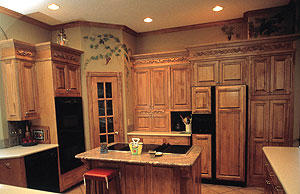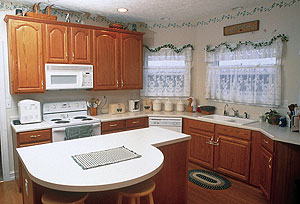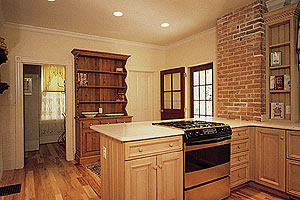Varnishes, Repairing Varnishes
Conversion finishes work where lacquer products fail because lacquer products don't have chemical resistance or water resistance. That’s why these products fail around dishwashers, where steam comes out, and in the bathroom, where water splashes on cabinets.
by Jeff Woodard

Chuck Crabtree that you get what you pay for. In fact, when it comes to bringing out the best in wood-cabinet finishes, Crabtree goes one better. “If you don’t want to spend the money to protect your cabinets, maybe you should look at a lower-end cabinet,” he says.
Crabtree is a firm believer that conversion varnish, though somewhat pricier than lacquer finishes, is an excellent finishing choice for consumers decorating with high-end woods such as alder, cherry and maple.
Conversion finishes work where lacquer products fail because lacquer products don’t have chemical resistance or water resistance, says Crabtree, owner of G&C Wood Finishing in West Sacramento, Calif. “That’s why these products fail around dishwashers, where steam comes out, and in the bathroom, where water splashes on cabinets,” he says.
 According to Bob McElroy, director of Chemical Coatings Division marketing at The Sherwin-Williams Company in Cleveland, Ohio, resistance to chemicals, abrasions and film-build are other notable qualities of conversion varnishes. According to Bob McElroy, director of Chemical Coatings Division marketing at The Sherwin-Williams Company in Cleveland, Ohio, resistance to chemicals, abrasions and film-build are other notable qualities of conversion varnishes.
Despite the price of higher-end finishes, Crabtree says the end result is well worth it. “It’s generally going to cost you about 20 percent of the cabinet price to apply a lacquer finish; 25 percent and up to apply a high-end conversion finish,” he says.
Paul Campbell, marketing director for The Rudd Company in Seattle, Wash., notes that a typical job requires only a couple of gallons of finishing product. “With high-end finishes costing only a few dollars more per gallon, the cost of finish relative to building materials is low.”

Conversion varnishes are best applied in a shop environment, for a number of reasons. One is the acid involved in the process, Crabtree says. “It’s not healthy to use it in a closed environment. It should be used in front of a spray booth to get rid of fumes, and it’s also temperature sensitive in the wintertime.”
Campbell says shop application also addresses the issue of wasted material. “Once catalyzed, those finishes can be used only for about 24 hours before they are no good. The life span and waste issue make it difficult to use on a job site.” In a shop environment, large-volume usage decreases the likelihood of waste, he says.
Crabtree says it’s easy to end up with voids when painters are working in the field, resulting in unfinished areas where liquid can penetrate. That’s less likely to happen in the shop. “We take all doors off, strip the cabinets, and ensure that there is no place for water to run down the cabinet and go up against the cabinet base,” he says. By finishing in the shop environment, Crabtree adds, there is no way for liquid to penetrate because all edges are sealed and finished.
Durability and resistance to yellowing are a couple of other notable qualities of conversion varnishes, Crabtree says. “It’s also resistant to household products that might stain, such as blueberry, catsup and mustard.”
Conversion varnish drawbacks include shorter pot life, increased cost and temperature sensitivity during winter. |

